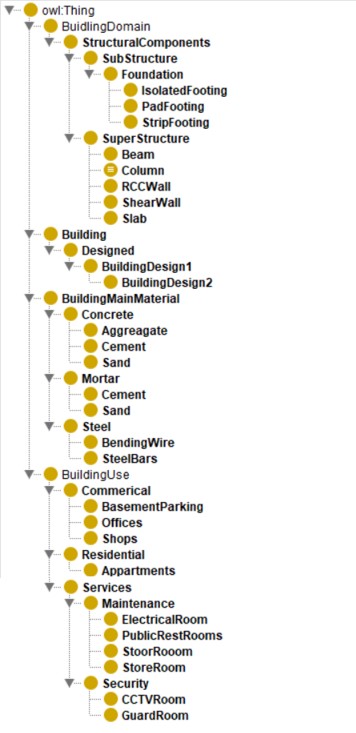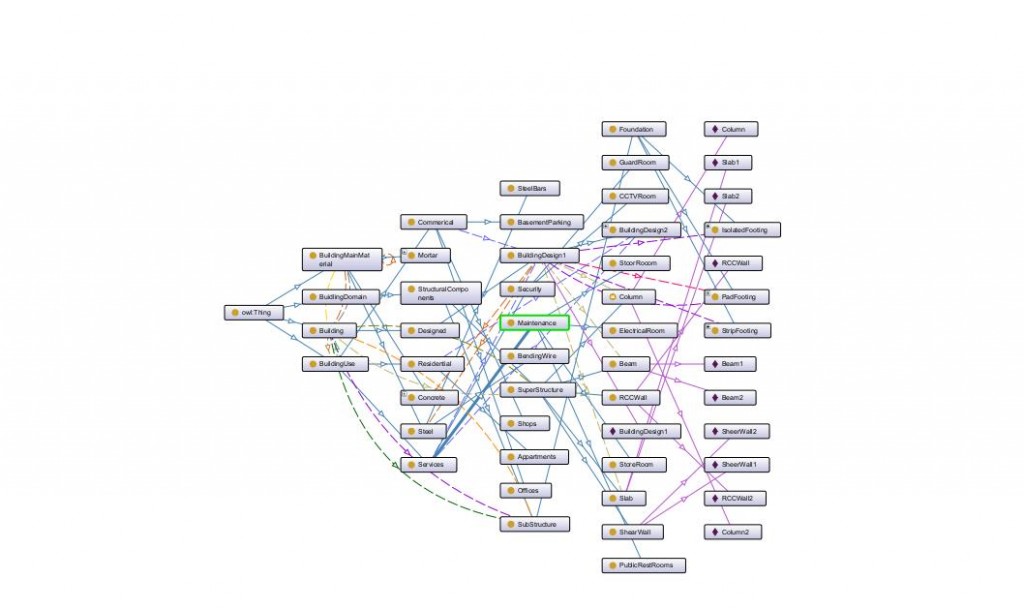Note: This ontology is not for bridge as the student switched the system for the second assignment.
Introduction
This ontology is developed for an RCC Multi Story Frame Structure Building.
- What is the purpose?
Establishing a structured knowledge framework for the design and construction of Reinforced Cement Concrete (RCC) Frame Structures in multi-story buildings is the goal of developing this ontology. The ontology seeks to support a number of applications, including parametric design, structural optimization, and decision-making procedures in building planning and engineering, by organizing the data pertaining to the elements, parameters, and design considerations of RCC Frame Structures. - What is the scope?
The representation of important ideas and connections related to RCC Frame Structures in multi-story buildings is included in the ontology’s scope. This covers structural element representation, comparative analysis of design alternatives for structural optimization, and parametric modeling of civil-engineered systems, including foundations, columns, shear walls, slabs, and elevator shafts. Furthermore, the ontology takes into account the variation in structural parameters brought about by various building uses, including mixed-use, residential, and commercial ones. - Who are the intended users?
Structural engineers, civil engineers, architects, building planners, and other construction professionals involved in the design, analysis, and construction of multi-story RCC frame structures are the main users of this ontology. These users use the ontology to retrieve structured knowledge pertinent to their area of expertise, which they then apply to collaborative building projects, design optimizations, and decision-making processes. - What is the intended use?
Structural engineers and building planners can improve the efficacy and efficiency of RCC Frame Structure design and construction processes by utilizing the ontology as a fundamental resource. It makes parametric modeling easier and allows users to compare the structural performances of different design options and investigate alternative designs for optimization. Additionally, by offering organized insights into the relationships between various structural components and their effects on building performance and safety, the ontology aids in the making of well-informed decisions. The ultimate goal of the ontology is to optimize the design and construction processes, which will enhance the multi-story RCC Frame Buildings’ structural integrity, economy, and sustainability.
Class Hierarchy
Once the classes and the instances were defined based upon the concepts described by Noy and McGuinness, the functional relationship between different classes and instances was mapped out using the axioms defined in the table above. The Ontology was then un through the Pellet Reasoner which further mapped out the inter relations between classes and sub classes based on the relationships and axioms defined. The class hierarchy can be seen below:
Ontograf
To view the ontology in the Protege, the OntoGraf plug-in is utilized. Following the creation of classes, hierarchy, and their relationships as axiomatic examples, we developed an ontology visualization for the Multi Story RCC Frame Structure Building, which is shown in figure below:
Engineering Examples
The use cases and example of the developed ontology are as follows:
- Design selection
The ontology defines the relationship between the building use, it’s size (Area, floors etc.) and it’s structural configuration i-e number of columns, beams, slabs and their structural and material parameters such as size, material composition etc. This relation would allow the user to choose a specific building design based on the intended use of the building.
- Design Optimization
Apart from being able to choose a design based on the intended use case of the building, the designers can also optimize the different parameters of design such as changing the column area, or the number of columns that exist in the building. This can be done based upon the relation of individual design elements with each other and other sub classes of the system. For example, if the user has to add a columns in BuildingDesign2, the user can only add 12 columns at max due to the At-most restriction. However, since there are two column direct instances, the user can choose from both available options in such a way that the cumulative load bearing capacity of the different combinations of the column can be used to support the whole building.
- Procurement of materials
The ontology builds a relationship between the structural instances, their properties and their intended use. This can be leveraged to build a knowledge repository for either building a manual or an automated process for ordering the required material for the building construction. For example, if the building can have at max 12 instances of Column, and each column is made up of Concrete having certain Cement, Sand and Aggregate Ratio (CSA Ratio) and a certain diameter of Rebar, that information can be fetched from the ontology and can be used to either perform quantity take offs or to procure the individual constituents of each building component when needed.
References
Ugwu, Onuegbu, et al. “‘Building Knowledge Level Ontology for the Collaborative Design of Steel Frame Structures.” ResearchGate, unknown, Aug. 2003, www.researchgate.net/publication/269812355_’Building_Knowledge_Level_Ontology_fo r_the_Collaborative_Design_of_Steel_Frame_Structures. Accessed 25 Nov. 2023.
“Concrete Frame Construction | Concrete Frame Structures.” Understand Building Construction, 2023, www.understandconstruction.com/concrete-frame-structures.html. Accessed 25 Nov. 2023
Naeim, Farzad. “Seismic Design of Reinforced Concrete Buildings.” Earthquake Spectra, Dec. 2014, https://doi.org/10.1193/112014eqs197b.
R Divya, and K. Murali. “Comparative Study on Design of Steel Structures and RCC Frame Structures Based on Column Span.” Materials Today: Proceedings, vol. 46, Elsevier BV, Jan. 2021, pp. 8848–53, https://doi.org/10.1016/j.matpr.2021.04.391. Accessed 25 Nov. 2023.
Noy, Natalya F., and Deborah L. Mcguinness. “Ontology Development 101: A Guide to Creating Your First Ontology.” ResearchGate, unknown, 2001, www.researchgate.net/publication/243772462_Ontology_Development_101_A_Guide_to _Creating_Your_First_Ontology. Accessed 28 Nov. 2023.
← Bridge | Group A – Homepage | Parametric Model →

